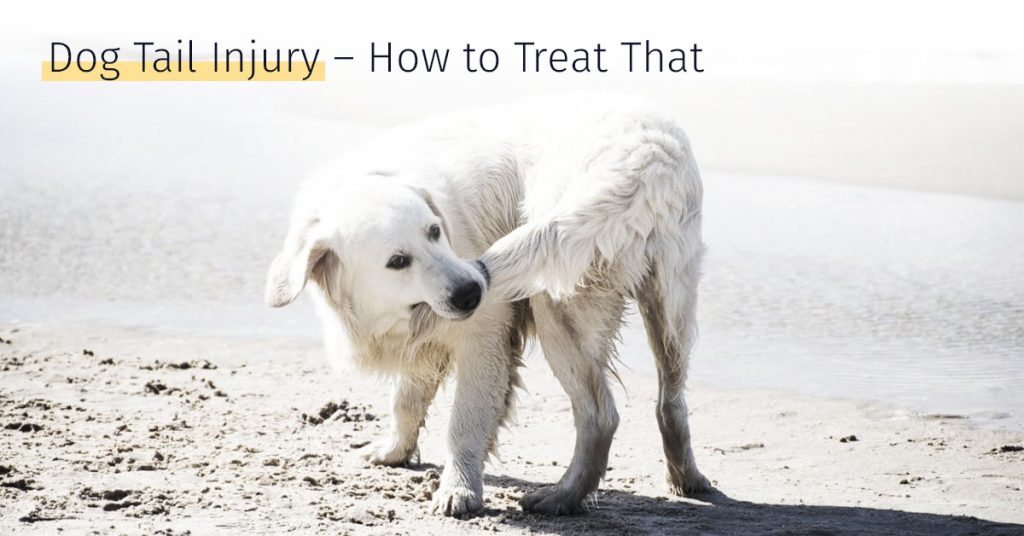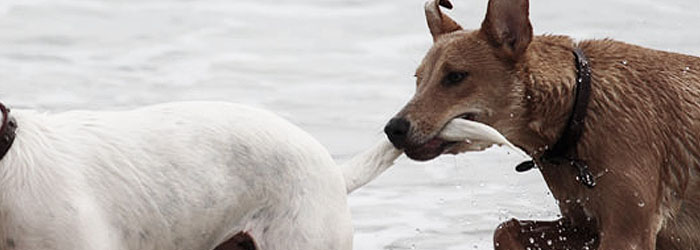
Dogs love to wag their tails as
The tail is a structure that is made of vertebrae. Soft disks help to cushion the spaces between the vertebrae, thereby allowing flexibility. Nerves and the tail muscles facilitate movement. They also play significant roles in bowel control.
If you notice that your dog finds it difficult to wag his tail, then there is trouble, and you should be ready to get him out of it as soon as possible.
Canine tails can get injured in several ways. They usually get caught in the door when it slams shut, thereby squeezing it against the doorjamb. It can also be accidentally stepped on, thereby hurting the complex tail structure which consists of muscles, bones, nerves, and blood vessels. Other forms of injuries to dog tails will be discussed later on.
It has also been observed that tail injuries occur much more frequently in dogs than in cats. Read on to discover more about dog tail injury and what you can do to treat it and minimize the chances of a re-occurrence.
Common Dog Tail Injuries
The following are some of the most common dog tail injuries. Here you can find out how you should handle them when they occur:
Happy Tail Syndrome

Some dog breeds are fond of wagging their tails vigorously and continuously. Thereby thumping them repeatedly against coffee tables, walls, or even trees. Excessive wagging of the tail can result in severe injury.
The happy tail syndrome can bring bleeding ulcers that may not heal on time, primarily because the tail-wagging, which is the source of the problem, won’t stop.
Injuries sustained via excessive wagging of the tail exposes delicate nerves which can cause severe pain to the dog.
This is why you should not even consider treating the dog by yourself. Visit the local veterinarian as soon as you discover the injury.
Sometimes, the vet may consider bandaging the area that is ulcerated along with pain medication and antibiotics, which help to calm the dog’s nerves and also prevent infection. This will help to make the tail heal faster.
In chronic cases – in which the wagging of the tail won’t stop thereby delaying the healing of the injury – one of the ways out of this predicament is a surgical shortening of the tail.
This will, no doubt, change your canine friend’s appearance. But if you look at the bright side, you will notice that short tails are far less likely to incur injury.
Happy tail injuries, in most cases, are usually not emergencies. However, they require proper treatment so that they can heal exceptionally well.
So, if you suddenly notice a raw spot on your pooch’s tail that wasn’t there before, contact the local vet as soon as possible.
Lacerations
Lacerations can be deep cuts that can expose underlying bones and muscles in the tail. In most cases, lacerations are self-inflicted by the dogs, especially when they are bored, nervous, or experiencing behavior problems.
Tail biting – which may also cause lacerations – can be as a result of impacted anal glands or flea allergies. The chances of infection are pretty high, particularly with bite wounds.
Some lacerations require surgical seams or sutures to heal correctly. The first thing to do when you discover lacerations on your dog’s tail is to wrap the tail in a soft towel to control the bleeding.
Then take your dog to the nearest veterinary clinic as soon as possible.
Fractured Tail
Tail vertebrae, just like other bones, can break if undue pressure is applied. A car accident can cause a fracture of your dog’s tail. It can also occur when his tail is accidentally caught in a door or when he falls
That how severe the fracture is in the tail significantly depends on the location of the trauma.
If, for instance, the fracture occurs at the tip of the dog’s tail, there is no cause for alarm. Such an injury can heal remarkably well without any clinical treatment. However, expect your dog’s tail to have a bump at the site of the fracture.
But if the fracture is so severe that the tail bones are crushed, your vet may have no choice but to amputate part of your dog’s tail. If the site of the fracture is near the base of the tail, it can be more severe since the likelihood of nerve damage is high.
So, do not hesitate if your dog is hit by a hit-and-run vehicle or has a nasty fall. Take him immediately to see the vet for a complete examination. You may be surprised to discover that other parts of his body may require attention other than the dog’s tail.
Tail Abrasions
There are dogs who are fond of wagging their tails against abrasive surfaces such as wire fencing or concrete steps. This can result in simple scrapes or abrasions.
Your dog’s tail may also get caught under a chair or other pieces of furniture. If the scrape takes off the hair on your dog’s tail and red skin is exposed, endeavor to clean that area warm water and mild soap.
Next, utilize antibiotic ointment and then bandage the tail lightly with a wrap. Do not use adhesive tape for this procedure.
You should also make sure that you do not bandage the tail too tightly so that it does not restrict blood flow.
Make sure you change the bandage every day and never forget to re-apply the antibiotic ointment. You can stop your dog from chewing at the dressing with the use of an Elizabethan collar.
Damage to Nerves in the Tail

The bony vertebrae adequately protect the nerves in your dog’s tail. However, these nerves can suffer an injury, such as avulsion trauma.
This type of injury usually occurs when your dog’s tail is pulled hard enough to tear the nerves. Breaks that occur near the base of your dog’s tail can also discerp nerves.
Sometimes, can happen accidents which may cause the nerves that control defecation and urination to be injured or affected.
If that is the case, the dog can become incontinent, i.e. lose control over defecation and urination.
However, with time and adequate care, nerve function may be restored. Some dogs may not heal from such an injury and will, therefore, remain incontinent for life.
Nerve damage can cause your dog’s tail also to hang limply, thereby making him unable to wag his tail or raise it to defecate.
Skin infections are rare with limp tails; but if you notice that your dog’s tail is hanging limply or he can’t wag it, contact your vet immediately.
Limber Tail Syndrome
This is a benign disorder that usually resolves on its own within a week, max. It is also known as swimmer’s tail, dead tail, and cold water tail.
Limber tail syndrome can be excruciatingly painful as it causes the dog’s tail to hang limply from its base.
It is a condition that comes on quickly and mostly occurs after swimming.
It is known to occur after a day of intense outdoor activities such as hunting or exercise. When a dog has this condition, the tail looks broken.
Although this condition resolves itself in a few days, you can expedite the process via proteolytic enzyme therapy for pain management. You can also make use of arnica and homeopathic aconitum, which are great remedies for the disorder.
Symptoms of Tail Injury in Dogs
The following are the symptoms of tail injury in a dog:
- Bending or drooping of the tail.
- Less wagging.
- Open and bleeding wounds.
- Overall swelling of your dog’s tail.
- The dog noticeably carried his tail between his legs for no apparent reason.
- A marked decrease in your pooch’s overall movement.
Treating Dog Tail Injury
The best way to treat a dog tail injury is to, first of all, clean up the tail, i.e. if it is an open wound. But if your dog won’t allow tail dipping, you should apply some ice cubes to the area to reduce swelling and numb the pain.
Sometimes, you may not know that your beloved pet is injured. This is why you need to watch out for observable signs such as hair loss, scratches, or bleeding on your dog’s tail.
You should, first of all, rinse off the wound by dipping the tail in a bowl of cold water for some minutes. This action stops the bleeding and also reduces inflammation.
Clean the wound by patting it dry with a clean piece of cloth, and then put on a small amount of antiseptic on the open wound. If, however, your dog will not allow tail dipping, again get some ice cubes and apply them to the wounded area.
Using ice is preferred because when there is a wound on an area as sensitive as a dog’s tail, chemicals known as histamines are released. These chemicals can cause inflammation and swelling, thereby resulting in permanent damage. But the use of ice cubes can prevent this process from occurring.
But if the case is a severe one, you should seek the care and treatment of a vet in your locality.
Healing depends significantly on the severity of the wound.
Spinal cord injury may also occur, and in this case, only a vet will know what to do.
Stem Cell Treatment for Dog Tail Injuries
The treatment with efficiency on another level in order to treat more threatening problems that can’t cure on their own is animal Stem Cell Therapy. It tackles the problem at its root. Because stem cells have the power to regenerate damaged tissues and thereby help to prevent their caused negative consequences. Even turn back tail’s movement after its loss. Medrego CaniCell Stem Cell Therapy speeds up the recovery time and promotes its effectiveness in the long term, and prevention of problem recurrence.
The best way to treat dog tail injury is to get your dog to a vet fast for proper examination, diagnosis, and treatment.
Conclusion
You can make a few changes within your pooch’s environment to minimize the re-occurrence of tail trauma. Start training your canine friend to curb his exuberance as this will help in preventing excessive tail wagging.
You should also find time to give your pooch plenty of exercise and dog toys with enough room to play. All this helps to drain that energy and tempers down the over excitement.
You should never confine your canine friend in tight spaces where he is likely to hit his tail against surfaces or walls.
But above all, always keep a close eye on your dog so that you can readily detect if something is wrong with his tail.
The Medrego team always suggests consulting a qualified veterinarian for personalized advice.



